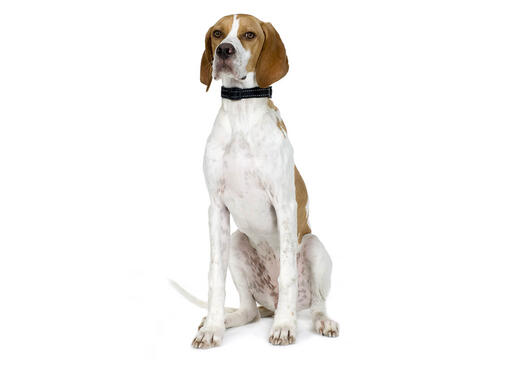
A true English hunting breed, the Pointer is an agile, athletic dog that is proud and elegant. He has a powerful, muscular body that gives him a noble confidence in the field. He also is a suitable family companion that is affectionate and protective at home. The enthusiastic, intelligent Pointer needs ample exercise and mental stimulation, and his smooth, dense coat requires minimal grooming.
DID YOU KNOW? The Pointer, which originated in England in 1650, was the first breed used to point game.
ALSO KNOWN AS: English Pointer
The need-to-know
- Dog suitable for owners with some experience
- Some training required
- Enjoys vigorous walks
- Enjoys walking more than two hours a day
- Large dog
- Minimum drool
- Requires grooming once a week
- Non hypoallergenic breed
- Quiet dog
- Not a guard dog
- May require training to live with other pets
- Great family dog
Personality

As companion dogs, Pointers are friendly and affectionate, and get on well with other dogs and even cats if introduced when young. They are closely bonded to their families and love to be included in everything that is going on. They are sensitive, intelligent and friendly and are welcoming of just about everybody. They are not ideal guard dogs but they will generally bark when someone comes to the door. As long as they are getting the exercise they need, they are quiet dogs in the house.
History and Origins

Country of Origin: England
The exact origin of the Pointer dog breed is not entirely clear: whether they originate from Spanish Pointers or from Continental Pointers is uncertain. Other breed historians say that their ancestors have always been English. What is certain however is that the English Pointer, a smaller, quicker dog than the continental Pointers, dates back to the 1600s and was used to 'point' game out to hunters. This is done by finding the game and then halting and indicating its presence rather than flushing it out. These are true canine specialists - and this coupled with their gentle disposition and obedient friendly natures has made sure they have always remained popular.
Nutrition and Feeding

Large breed dogs, as well as having large appetites, benefit from a different balance of nutrients including minerals and vitamins compared to smaller-breed dogs. This breed can be prone to bloating and stomach problems; smaller, more frequent meals can help minimise this risk.
Exercise

At heart the Pointer is still a working gundog and so needs plenty of exercise every day to include free-running. A fit adult needs two-plus hours of daily exercise but will always be up for more.
Other Information

Health and common issues
Pointer dogs are relatively hardy dogs. As with many breeds, hip dysplasia (a condition that can lead to mobility problems) may occur and hip scoring of dogs prior to breeding is therefore important. The breed club monitor the health of the breed carefully and should be contacted for the most up-to-date information and details of any DNA or additional testing they recommend. Breed Clubs can be found on the Kennel Club website.
Space requirements
This is a country dog who needs a good size home and plenty of countryside to exercise in.
Training pointers
The Pointer is an intelligent, biddable dog who will try their best to please their owners but if they are to be the star of the class, they need opportunities to show off what makes them such fabulous gundogs! Pet gundog classes or even scent work classes will be ideal for a Pointer. They should however be taught a reliable recall as outside they can easily be distracted by the thrill of the chase or just the joy of running. Some may only be safe off-lead in enclosed, totally safe areas.
Best family dog breeds
Pointers make excellent family dogs for active outdoorsy families who can give them the exercise they need. While many dogs are traditionally thought of as being good with children, all dogs and children need to be taught to get on with and respect each other, and be safe together. Even so, dogs and young children should never be left alone together and adults should supervise all interactions between them.
Did you know?
- You can trace the history of Pointers through art. Early pointers have been found depicted on the walls of 3,000-year-old Egyptian tombs, as well as French and English painting from the 17th to 19th centuries.
- Despite still being used as a working breed today, they love their creature comforts and enjoy nothing more than cuddling up on the sofa.
- Even before guns, Pointers were excellent bird catching dogs. They’d capture the bird and either break their neck or take it back to their handlers for them to finish the job.
- The name ‘Pointer’ is because when they spot prey, they literally point their entire body to the thing in question.